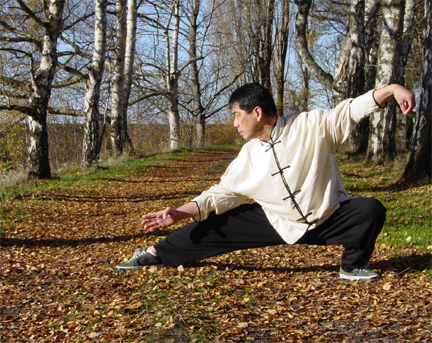Taijiquan move #1: Snake Creeps Down

When you look at the nice slow movements of Shotokan's Heian Yondan wrestling is the last thing that comes to your mind- if it ever comes to mind at all.
With Taijiquan the uninitiated observer will also not think of grappling when he sees much of the movements shown in Taijiquan forms.
This particular move took my karate mind a while to get around. Sure- in Karate we have a back stance that looks like this half-split stance used in the move we call (look at the post's title!) "Snake Creeps Down". We have a hand movement that looks very much like the one in this move which we know to be a knife hand block.
Now I want to know why the hell I'd want to crouch all the way down to deflect a kick away from my shin...
Hehe!
Sure- forms have lots of blocks and punches, but not everything is a strike or a block.

If we leave the cannonating pushes and heart-stopping punches out of the discussion for a while we can take a closer look at what is one of the most refined grappling techniques in all of the martial arts that I know of.
By now I am sure that many of you have seen takedowns that involve a hooking with the leg, a push with the hip and the horizontal pull with the hands. Most martial arts have that. Now what about a downwards pull?
In Japanese martial arts that is not so unusual as you may think. Besides the extreme example of Judo's Tomoe Nage (stomach throw) Aikido has throws that require the user to drop into seiza (kneeling) position.
Pulling straight downwards will not be of much help, but pulling a person diagonally downwards is a certain way to disrupt his balance.
That is why my preferred application of this move involves pulling the opponent downward to the side of the arm that I am holding while I scoop up his leg with my free arm. Taking it further will end up looking like you are punching with an uppercut like this...
Practicing this with a partner will reveal that you have actually now learnt a more stable and more efficient version of Judo's Kata Guruma (shoulder wheel). Now this comes from a martial art that predates Judo by roughly a millenium. I'd even go as far as to say that Jujutsu is a couple of centuries younger than Taijiquan.

Hua sai! The Chinese knew Judo before Judo was even invented!
Something that learning this move has taught me is that changes of height in forms have huge significance, whether it be Karate, Taekwondo or Kungfu.
Next time you do a kata where you have to go from a low stance to a high one, look at what your arms are doing. Something is being lifted....
When you have to drop down to a kneeling position it is most assuredly not to block a kick to your shin. Someone is most likely being pulled down.
Now- biokineticians and chiropractors are bound to tell you that:
1. Your knees should rather not bend beyond 90 degrees;
2. Lifting heavy weight with your back is asking for permanent trouble.
In Judo these difficulties are overcome by using the opponent's forward momentum to get him onto your shoulders so that he can practice his ukemi at the other end of the throw. At least that is how it should be, but we know that in real life the stationary opponent is lifted like a sack of potatoes.
With Snake Creeps Down no actual lifting is necessary. Instead the "creeping" hand is driven forward and diagonally upwards while the hips push more forward that upwards. Even against a larger opponent it does not feel like you are lifting someone heavy.
That's it for today.
What Taiji move should I discuss next week?







Comments
Post a Comment